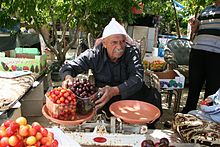Majdal Shams
This page is subject to the extended confirmed restriction related to the Arab-Israeli conflict.Majdal Shams (Arabic: مجدل شمس; Hebrew: מַגְ'דַל שַׁמְס) is a predominantly Druze town in the Israeli-occupied Golan Heights,[3][4] located in the southern foothills of Mount Hermon.
Majdal Shams played a significant role in the Great Syrian Revolt of 1925–1927 that was led by Druze leader Sultan Al-Atrash, who is commemorated by several monuments in the city.
Since the 1967 Arab–Israeli War, Majdal Shams along with the broader Golan Heights have been under Israeli occupation,[5] and effectively annexed in 1981, in a move only recognized by the United States.
[6] Majdal Shams is the largest of the four remaining Syrian Druze communities in the Israeli-occupied territories of Golan Heights,[7] the other three being Ein Qiniyye, Mas'ade, and Buq'ata.
While the Golan Heights and Mount Hermon are administratively joined, they differ geologically and geographically, with their boundary being marked by the Sa'ar Stream; Majdal Shams and Ein Qiniyye sit on limestone on the Hermon side, while Buq'ata and Mas'ade are on the Golan side, which is characterized by black volcanic rock (i.e., basalt).
The name "Majdal Shams" originates from Aramaic, meaning: "tower of sun" in reference (possibly) to the town's elevation.
[13] W. M. Thomson reported that in 1846, the large village "Mejdel es Shems, [was] inhabited by Druses, a fierce, warlike race, sufficiently numerous to keep the Bedawîn Arabs at a respectful distance.
[15] Majdal Shams also attracted foreign geologists such as William Libbey because of the town's proximity to an exposed strata of Jurassic period fossils.
"[18] James Kean, who wrote about the town in the 1890s, described Majdal Shams as a "remarkable village" and noted that it was "famous for the manufacture of steel blades.
Mandate authorities sent troops to restore order, and community leaders contacted the central command of the revolt for assistance defending the town against the French.
Zaid al-Atrash drove French troops from the area and established a rebel garrison in Majdal Shams to guard the road between Damascus and Marjayoun.
During the 1936–39 Arab revolt in Palestine, traditional leader Assad Kanj Abu Salah proposed forming a local militia to assist the rebels.
[5] During the 1967 Six Day War, residents of the nearby towns of 'Ayn Fit, Banias, Jubata ez-Zeit, and Za'ura took shelter in Majdal Shams.
Residents frequently gathered at the eastern edge of the village with bullhorns to shout messages to friends and relatives on the Syrian side of the ceasefire line.
Although Israeli troops blockaded the town and offered residents to accept citizen identification cards, the protesters succeeded in convincing the state to classify members of the community as non-citizens.
[36] During the 1970s, a few residents of Majdal Shams received permission to cross the ceasefire line into Syrian-controlled territory, either to rejoin relatives or attend university in Damascus.
[37][38] During the 1990s, large numbers of residents began to receive permission to cross the ceasefire line to conduct religious pilgrimages or attend university.
[43][44] Following this, the Jewish Agency, JFED of North America, and Keren Hayesod announced 600,000 NIS in donations to the town, stating in a letter, "We see the Druze community as family.
[54] As permanent residents, Majdal Shams inhabitants are free to work and study in Israel and are entitled to state services such as HMO (Kupat Holim) health insurance.
However, the Syrian civil war has halted this trade, forcing local growers to sell their apples in Israel, where they struggle to compete with market prices.
The scenic landscape, characterized by rows of apple and cherry trees interspersed with vegetable plots, provides a picturesque backdrop for agritourism.
[57] One kilometer east of the town center is Shouting Hill, where residents used to line up with bullhorns to make small-talk with relatives on the Syrian controlled side before the advent of cellphones.
Abu Jabel's factory specializes in knafeh, a dessert featuring kadaif noodles, cheese, sugar syrup, and pistachios.





